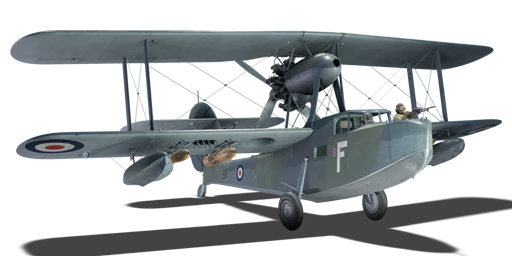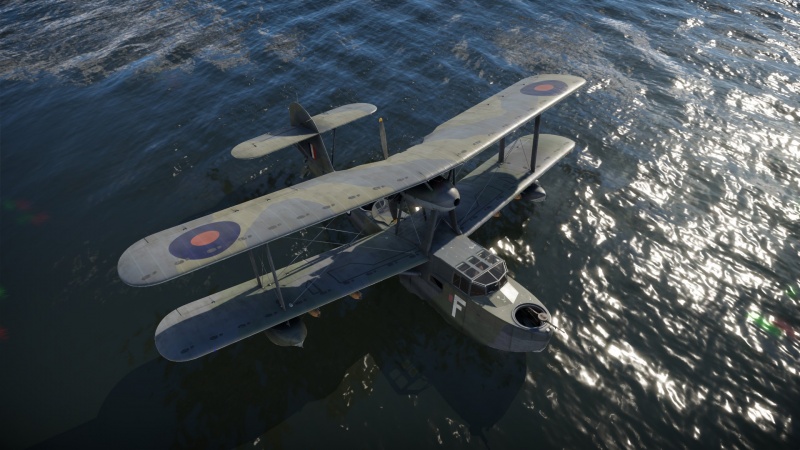Walrus Mk.I
Contents
Description
The Walrus Mk.I is a gift rank I British bomber with a battle rating of 1.3 (AB/SB) and 1.0 (RB). It was introduced in Update "Winged Lions" as a ship-launched reconnaissance aircraft.
Ships that carry the Walrus
General info
Flight performance
Describe how the aircraft behaves in the air. Speed, manoeuvrability, acceleration and allowable loads - these are the most important characteristics of the vehicle.
| Characteristics | Max Speed (km/h at _,___ m) |
Max altitude (metres) |
Turn time (seconds) |
Rate of climb (metres/second) |
Take-off run (metres) | |||
|---|---|---|---|---|---|---|---|---|
| AB | RB | AB | RB | AB | RB | |||
| Stock | ___ | ___ | 9200 | __._ | __._ | __._ | __._ | ___ |
| Upgraded | ___ | ___ | __._ | __._ | __._ | __._ | ||
Details
| Features | ||||
|---|---|---|---|---|
| Combat flaps | Take-off flaps | Landing flaps | Air brakes | Arrestor gear |
| _ | _ | _ | _ | _ |
| Limits | ||||||
|---|---|---|---|---|---|---|
| Wings (km/h) | Gear (km/h) | Flaps (km/h) | Max Static G | |||
| Combat | Take-off | Landing | + | - | ||
| 0 | 450 | ___ | ___ | ___ | ~__ | ~__ |
| Optimal velocities (km/h) | |||
|---|---|---|---|
| Ailerons | Rudder | Elevators | Radiator |
| < ___ | < ___ | < ___ | > ___ |
Survivability and armour
Examine the survivability of the aircraft. Note how vulnerable the structure is and how secure the pilot is, whether the fuel tanks are armoured, etc. Describe the armour, if there is any, and also mention the vulnerability of other critical aircraft systems.
Armaments
Suspended armament
The Walrus Mk.I can be outfitted with the following ordnance:
- 4 x 250 lb G.P. Mk.IV bombs (1,000 lb total)
Defensive armament
The Walrus Mk.I is defended by:
- 1 x 7.7 mm Lewis machine gun, nose turret (485 rpg)
- 1 x 7.7 mm Lewis machine gun, dorsal turret (485 rpg)
Usage in battles
Describe the tactics of playing in the aircraft, the features of using aircraft in a team and advice on tactics. Refrain from creating a "guide" - do not impose a single point of view, but instead, give the reader food for thought. Examine the most dangerous enemies and give recommendations on fighting them. If necessary, note the specifics of the game in different modes (AB, RB, SB).
Pros and cons
Summarise and briefly evaluate the vehicle in terms of its characteristics and combat effectiveness. Mark its pros and cons in the bulleted list. Try not to use more than 6 points for each of the characteristics. Avoid using categorical definitions such as "bad", "good" and the like - use substitutions with softer forms such as "inadequate" and "effective".
Pros:
Cons:
History
The Supermarine Walrus (or the Supermarine Seagull V, its original name) is a British single-engine amphibious biplane designed by Supermarine's R. J. Mitchell at their works at Woolston, Southampton. Primarily used as a maritime patrol aircraft, it was the first British squadron-service aircraft to incorporate an undercarriage that was fully retractable, crew accommodation that was enclosed, and a fuselage completely made of metal.
The Walrus first flew in 1933, the design process having started as a private venture four years earlier. It shared its general arrangement with that of the earlier Supermarine Seagull. Having been designed to serve as a fleet spotter launched by catapult from cruisers or battleships, the aircraft was employed as a maritime patrol aircraft. Early aircraft featured the original metal hull design for its greater longevity in tropical conditions, while the later variant, the Supermarine Walrus II, instead used a wooden hull to conserve the use of light alloys.
Media
- Videos
See also
Links to the articles on the War Thunder Wiki that you think will be useful for the reader, for example:
- reference to the series of the aircraft;
- links to approximate analogues of other nations and research trees.
External links
Paste links to sources and external resources, such as:
- topic on the official game forum;
- other literature.
| Supermarine | |
|---|---|
| Spitfires | |
| Merlin engine | Spitfire Mk Ia · Spitfire Mk IIa · Spitfire Mk.IIa Venture I · Spitfire Mk IIb |
| Spitfire Mk Vb · Spitfire Mk Vb/trop · Spitfire Mk Vc · Spitfire Mk Vc/trop | |
| Spitfire F Mk IX · Spitfire F Mk IXc · Spitfire F Mk XVI | |
| Spitfire LF Mk IX · Plagis' Spitfire LF Mk IXc | |
| Griffon engine | Spitfire F Mk XIVc · Spitfire F Mk XIVe · Prendergast's Spitfire FR Mk XIVe · Spitfire F Mk XVIIIe · Spitfire F Mk 22 · Spitfire F Mk 24 |
| Export | ▄Spitfire Mk Vb/trop · ▃Spitfire LF Mk IXc · ▂Spitfire Mk IXc · Spitfire Mk IXc · Spitfire Mk.IX (CW) · Weizman's Spitfire LF Mk.IXe · ▄Spitfire FR Mk XIVe |
| Seafires | Seafire LF Mk.III · Seafire F Mk XVII · Seafire FR 47 |
| Export | ▄Seafire LF Mk.III |
| Jet fighters | Attacker FB 1 · Attacker FB.2 · Scimitar F Mk.1 · Swift F.1 · Swift F.7 |
| Hydroplanes | Walrus Mk.I |
| Ship-launched reconnaissance aircraft | |
|---|---|
| USA | O3U-1 · OS2U-1* · SOC-1 |
| Germany | Ar 196 A-3* |
| USSR | KOR-1 |
| Britain | Osprey Mk IV · Walrus Mk.I |
| Japan | E7K2 · E8N2 · E13A1 · F1M2* |
| Italy | Ro.43 |
| France | GL.832HY · Loire 130С |
| *Available standalone in tech tree | |





